
Fifteen years after abandoning a proud tradition, we are pleased to see that Apple will once again produce a beige computer. Too much sparkle, though.

Fifteen years after abandoning a proud tradition, we are pleased to see that Apple will once again produce a beige computer. Too much sparkle, though.
“Ok so this is my post. Sex workers who do sex work by choice do exist. Sex workers who enjoy their jobs do exist. Sex workers who feel empowered by their jobs are out there and exist. But do not speak as if they are the norm and they speak for all us current and former sex workers. As a Black genderfluid person who has done sex work to survive rather than live in complete poverty and in circumstances I did not want to live in, that was my choice. But it was a choice that was funneled through my gender, my race, my status as a felon, my status as someone without a lot of financial capital, my status as a queer person. The options available for Black and brown girls to do their dream jobs, to never sacrifice their pride, to never do jobs they do not want to do are few and far between. Sex work is sometimes an avenue that provides us revenue or a way to survive. It is not always our top choice. But like many Black and brown women do regularly, we swallow our pride to feed ourselves, our family, our loved ones, pay bills, whatever. Capitalism and white supremacy and patriarchy are disgusting. Anti-blackness is disgusting. These things place beautiful human beings in positions where they have to do things to make money and to survive they don’t always want to do. But that doesn’t make us less. Just because you would rather clean toilets or work at McDonalds or write or sell photos or whatever rather than fuck or dance or massage or whatever other sex work some of us might do to survive DOES NOT MAKE YOU BETTER THAN US. you made your choice based on the limited choices you have. sex work isn’t inherently dirty or bad. treating women like objects are. murdering women (trans* and cis) for being involved with sex work is wrong. treating us like we are less than you because we have sex or do other sexual activities is wrong. men who think they can get our services for free are wrong. locking us up is wrong. If you want to ask about sex work and you aren’t in the field, make that clear. If you want to learn from us, you better make sure that’s what you want. And at the end of the day, sex workers of various backgrounds have various opinions and views. I do not speak for all sex workers. No one sex worker does. Someone who is a Black trans* woman and doing full service sex work in DC might have a bunch of different things to say on the topic than I as a Black perceived women but genderfluid middle class chunky stripper/service via the strip club industry sex worker. Regardless tho, we are humans. We are worthy. We are beautiful. We are hustlers. We are survivors. And none of you non sex workers are better than us. None of us. Respect our words and respect our boundaries and when you don’t, you are worse than a lot of people who already treat us like garbage just for being us.”—
D. Strugg
quoting myself because i can. don’t even be fucking w/ sex workers, former and current. just don’t.
(via strugglingtobeheard)
I’m a sex worker and I approve this message.
(via pervertsofcolor)
same
(via chatmaudit)
I always appreciate the input and/or backup of fellow sex workers or former sex workers. Thank you.
(via strugglingtobeheard)
Johan PalmeThis is pretty ridiculous/amazing. :D
It would seem to be some necessary rule of capitalism that as one of the top luxury brands in the world, Prada, which is worth somewhere in the neighborhood of $15.5 billion, would have to tone it down somewhere along the way—get more boring to please investors, settle into the comfort of high profits and handbags and careful designs. Not Miuccia! Yesterday, as part of Milan Fashion Week, Prada and its 64-year-old namesake designer Miuccia sent down one of their weirdest collections ever, with heavily bejeweled bras on top of dresses, fur coats splattered with women’s faces and illustrations of sunrises (for spring, no less!), a luxe take on Tevas, leg warmer athletic socks, feathered headdresses and a color palette that looked like a crayon box. None of those pieces should work together; actually, none of those pieces should work alone. But while she could easily coast on a sea of brand recognition and high heels, Miuccia is interested in the unexpected combinations that are truly new. And because she does them so expertly, with so much thought and intelligence, the ugly becomes appealing.
In his review of the collection, Tim Blanks writes that Miuccia was inspired by feminism, Riot Grrrl, girl gangs, tribalism, political street art and Britney Spears. That all these elements are so, so different is exactly the point. So many other designers settle into cliches about the “woman”—sex goddess! downtown It girl! uptown socialite!—but Prada knows that actual lives are complicated, and no woman could possibly be summed up in a single stereotype. Riot Grrrl is as alive in the culture as Britney Spears is, and that’s okay. That’s the truth of how life in this world actually is, full of contradictions. Let’s call it fashion realism. Critics are saying, moreover, that featuring faces on the garments is a comment on the over-objectification of women’s images on billboards and magazine ads. Miuccia is a former activist member of the Communist Worker’s Party, after all, which all sounds radical until you quickly remember that Prada, as a major luxury company, is more guilty of using objectification to sell products than almost anyone else. But maybe that’s just another aspect of the ball of contradictions that Prada has come to represent. “I saw them as strong, visible fighters,” she told Vogue, speaking of the women who would be wearing her clothes. “We need to be fighters in general. There is this debate about women again, and I want to interpret it. My instrument is fashion.” But her quote hides the whole story, a bit: sure, her ladies are fighters, but maybe there’s weakness in there, too. Prada can be bad and good, moral and immoral, ugly and beautiful, at the very same time, just like us. In fact, it’s the contrasts that Prada refuses to shy away from that makes her brand, and fashion in general, a much weirder, more honest place.












(via Style.com)
His character has nothing to do with his skin colour and therefore I decided to make him white; this should not bring up the impression that white people are more valuable than black people, it is quite the contrary – the reason for this is that white is a neutral colour.
Music styles that, like hip-hop, are connected to some kind of grass roots, are fluid, with constant incremental changes building into epochal ones. When they move from their base audience, it’s often because a particular conjuncture of sounds resonates with a new crowd. But here is where a kind of misrecognition occurs: for the neophytes, the style is this one way, frozen in time. The give and take between music makers and their core followings, the push and pull, ebb and flow that built disco, hip-hop, house, reggaeton, and so on, is interrupted by listeners who in their enthusiasm don’t always understand the history or sociology of their genres. They don’t have to: when music becomes a commodity, it can travel worldwide, as all commodities do, severed from any knowledge of the conditions of its production. Genres cease to be grassroots social worlds, and instead become something more like brands: mere sonic surfaces rather than deep historical processes.
When a genre develops a signature sound, it’s ripe for the plucking by interlopers. Instead of having any real connection to the communities that develop musical styles through the dialectical movement between music makers and their core audiences, an outside producer just has to have a decent set of ears and a computer, and can start cranking out reasonable facsimiles, like factories in China churning out fake Coach purses indistinguishable to everyone but connoisseurs. Even if you can tell the difference, the functional parts are close enough. Today’s Chinese pirate manufacturers pride themselves on their quality goods, just as today’s kings of musical appropriation do.
Johan PalmeSelfshare
It was so successful it had to be hunted down, packed up and sent out again. The travelling exhibition Dynasty and Divinity: Ife Art in Ancient Nigeria (tiresomely renamed “African Masterpieces” — but that’s another story) has come to Stockholm after it was already disassembled and back in Nigeria, having successfully toured nearly a dozen cities across Europe and the United States. It has by all accounts been a rip-roaring success of Nigerian (and Yoruba) nationalist PR, with journalists ladling on the justified hyperbole (“an exceptional exhibition … artworks that rank with the Terracotta Army, the Parthenon or the mask of Tutankhamun as treasures of the human spirit”) — made possible through close economic and social co-operation between some of the biggest, most powerful historical museums in the former colonizing powers and the National Commission for Museums and Monuments in Nigeria. The latter owns the artifacts in the exhibit, packaged it, co-selected and co-organised it, and sends two officials to participate and learn throughout each exhibition period. The co-operation is to its significant benefit.
And yet — the shadows of the flames still flicker.
On February 18th, 1897, the British army perpetuated one of the greatest premeditated crimes against the world’s cultural heritage, well comparable to the burning of the library in Alexandria. In a pre-planned move, an army unit entered Ife’s huge successor city-state Benin and utterly destroyed it, wrenching its artworks off the walls and piling them as scrap, systematically burning down each palace in turn before reducing the king’s palace to rubble. Of the largest pre-colonial walled city in West Africa remained a burnt-out husk, and thousands of invaluable artworks were irrevocably lost. Others, some 2500 objects in total, were sold and now form a crucial part of the collections of African artworks at every European museum. All of the institutions involved here (including the Swedish Museums of World Culture) have, directly and indirectly, benefited enormously from the looting of 1897.
It is no wonder, then, that the exhibition has received significant criticism from inside Nigeria. How can the Nigerian government be willing to lend treasured objects to an institution that, just a few hundred meters away, still keeps the shameful products of colonialism’s crimes? The answer, from the government perspective, is quite sensible in some ways: it’s working, but silently.
“We’re using this exhibit to share Nigeria’s past with the rest of the world, modifying Nigeria’s image,” Yusuf Abdallah Usman, Director General of the National Commission for Museums and Monuments, told me at the press showing. “For institutions, we’re showing that even if the artifacts were returned, we’re still able to lend them out, they can still come back, they’re not disappearing inside Nigeria forever.” And they’re working quietly behind the scenes, co-operating, trying to find common ground: “We’re talking among our colleagues, holding a series of meetings. It may not be earth-shattering, but dialogue is really the only way that works in these matters. I firmly believe that one day, all the artifacts will be returned to Nigeria.”
The Nigerian government is using the co-operation built up during exhibits like this in order to try to get the desired results.
Fair enough.
But goodwill is a fragile hope indeed, and to an extent the co-operation is a two-edged sword: push too forcefully, and the exposure, the profitable exhibits and the training exchanges are going to disappear. Considering the power structures that prevail in the post-colonial world, perhaps this lucrative self-gagging is indeed the best use of a limited freedom of action for now, but will it really have the desired effect in the long term? It may be that the former colonial powers have too much of their conceptual position invested in the idea that they have the right to retain these objects. As art historian Jonathan Harris writes with respect to the British (p. 275, quoted in the article above):
To return [the Benin artefacts] would imply the belief, on the part of the British authorities, that the peoples of those parts of the world were now capable of competently looking after artefacts … Their return would also imply admission of their illegal possession by the British. Both implications remain largely unthinkable because post-imperial racism continues to be a highly significant aspect of British foreign policy.
* The exhibition Afrikanska Mästerverk (African Masterpieces) is shown in the Skeppsholmen Caverns in Stockholm until February 2014.
Johan PalmeVery consistent, only one or two duds in a collection both varied and tightly held together. One of my fave shows overall this season so far.
Johan PalmeHahaha, the giant shoes!!!
Johan PalmeIt's not as good as F/W13, but once the capes appear I'm sold.
Johan PalmeI CAN'T THANK LONDON ENOUGH for bringing back some sanity to the fashion world, in the form of ripped-apart Thai Coca-Cola Vikings.
Johan PalmeAnd this Lace Borg thing. Did anything at NYFW even begin to be this interesting?
Johan PalmeI'm not sure I like it, really, but at least it's doing something during what's proving to be one of the dullest new York Fashion Weeks ever. (Click the title, not the picture, for the slideshow.)
Johan PalmeOh dear. Especially the last one. :o
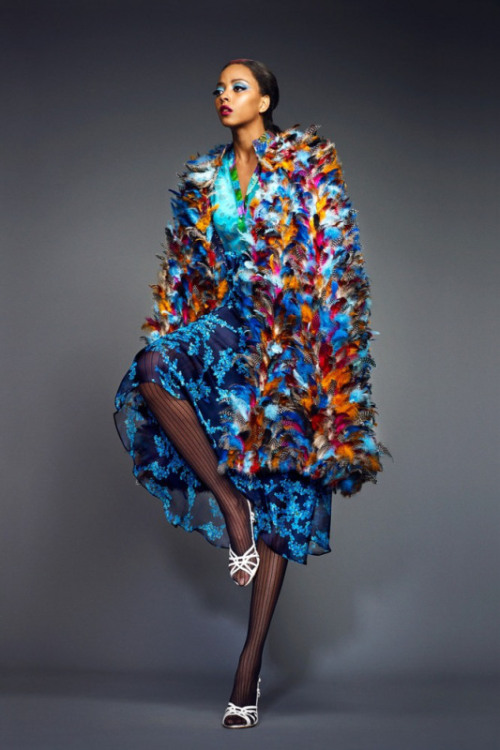
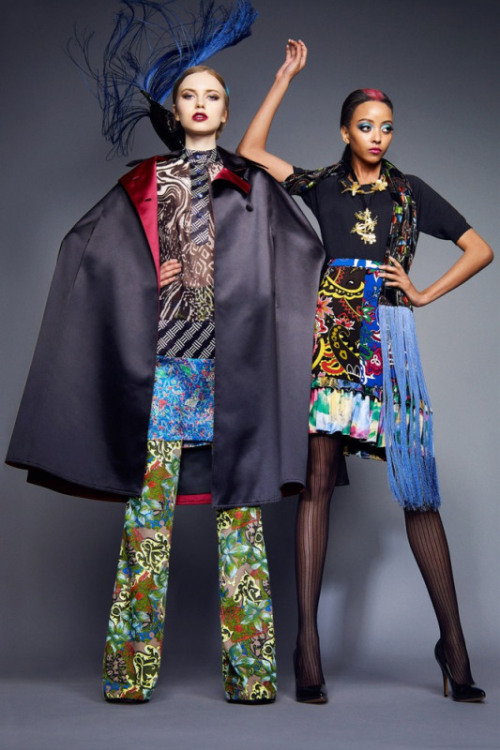
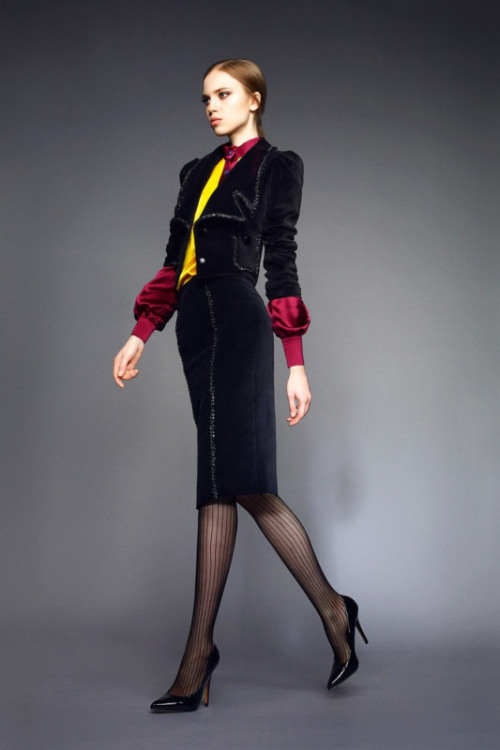

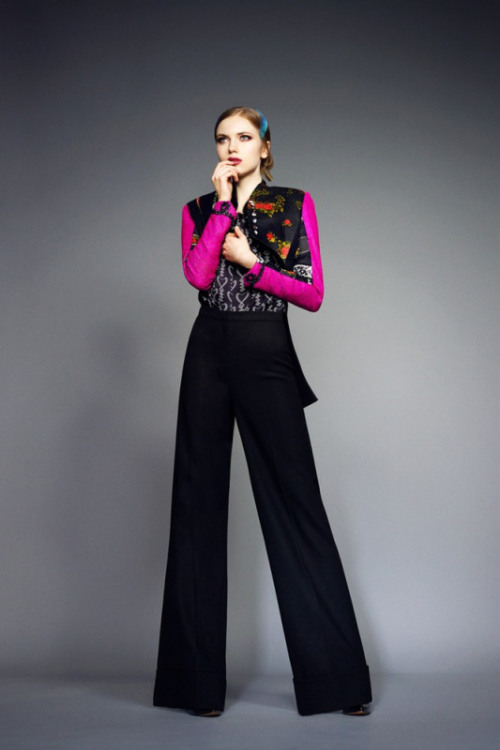
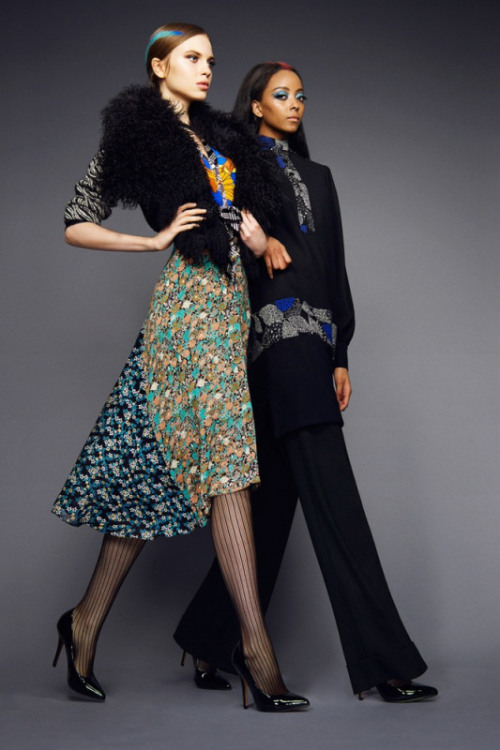
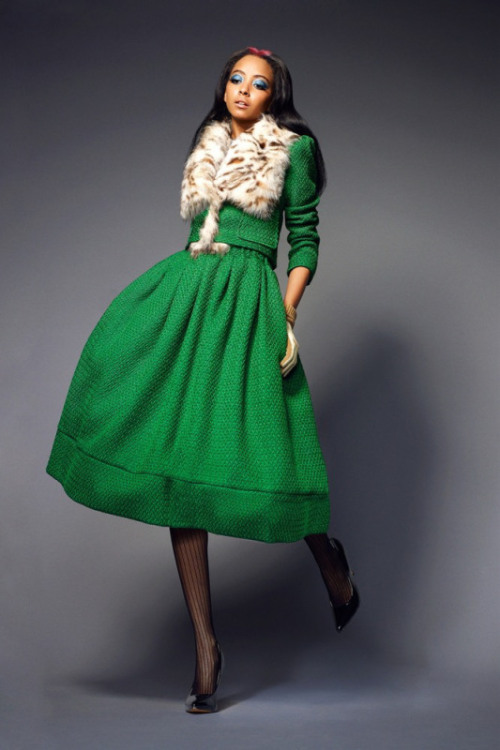


Duro Olowu Fall/Winter 2013/2014 (pt. 1)
Striking prints and patterns, arresting colours and classic silhouettes! YES!
Johan PalmeHooray for weird Trompe d'oeil!

FADER NYFW, Spring 2014
The writing was on the wall when See By Chloé sent out their fall 2012 collection in front of a marble backdrop. A year later, Alexander Wang would transform the luxe tile into the focal textile of his debut fall 2013 collection for Balenciaga to rave reviews. Other designers clearly took note and put their own spin on the pattern this NYFW. Phillip Lim, pictured above, showed angular vests in marbleized woodgrain. Robert Rodriguez added dimension to the flat fabric with a dark, sculptural tiered dress. Creatures of the Wind went in another direction, using a lighter pattern for a breezy, flounced skirt. Nicholas K’s interpretation had a ghostly quality with a washed out, gauzy pantsuit. And Rachel Comey and Peter Som chose marble patterns reminiscent of lava lamps that make for covetable sweatshirts. Some designers took the floor even effect further, showing screen-printed wood patterns. Honor’s take was more literal than Zimmerman’s but both transformed the grainy floorboard into stellar cocktail hour dresses.
Peter Som
Robert Rodriguez
Creatures of The Wind
Rachel Comey
Zimmerman
Honor
Johan PalmeOne of the best shows of NY Fashion Week so far. I like the repeating auroraesque pattern.
Johan PalmeVery interesting collection! Only a bare minimum of duds and lots of great ideas.
Johan PalmeOH YES
By Jennifer Obiuwevbi
 It was a fabulous day for Vlisco as they launched their third collection for 2013 – Reflexion Optique.
It was a fabulous day for Vlisco as they launched their third collection for 2013 – Reflexion Optique.
Held at their chic head office in Ikeja, Lagos the beautiful collection was creativerly crafted to unveil the unseen sides for consumers with with fabulous opportunities for designing eclectic and out-of-the-box outfits.
The collection and campaign features a variance of colours, geometric patterns and playful optical illusions. According to the brand “the key concept behind this collection is that, any woman adorned in this collection of fabrics is able to reveal every side of her personality using motifs that can be tailored to suit any mood and creative disposition.”
View some photos from the launch and the Vlisco pieces in action as models strut the runway.
Check out the “Reflexion Optique” campaign photos for the collection below.
Photo Credit: Launch Photos: Iphy Photos
Tags: African fabrics, Africxan fashion, Iphy Photos, Lookbook, Reflexion Optique Collection, vlisco, Vlisco 2013 collection
Filed under: News & Features
Johan PalmeSound Studies!
A student recently asked if I had any insights into why the “Amen Break” is so popular in some modern music. “What’s that?” I had to admit that I hadn’t heard of it. But when we listened to it, a drum break beat, I recognized the rhythm right away. I’d heard it in television commercials and the music of James Brown, and elsewhere. You probably have too. I became intrigued when I saw an image of the audio waves themselves because I immediately recognized the Golden Ratio in the structure of its timing. And I was surprised to find an even deeper relationship to the structure of the human body.
Johan PalmeI'm working on getting this shown in Stockholm
JON FROSCHSEP 6 2013, 7:30 AM

In an edition of the Venice Film Festival notable for the prevalence of works grappling with global and societal woes (unemployment, terrorism, pollution,war) perhaps no film has blended the personal and the political as strikingly as Abdellah Taia’s L’Armée du salut (Salvation Army).
A promising directorial debut presented in the independent “Critics’ Week” category on Wednesday, the movie is adapted from Taia’s autobiographical novel about growing up gay in Morocco.
Today, the 40-year-old Taia is the only openly homosexual Moroccan writer-filmmaker. He is based in Paris, where he moved in 2000 to pursue a graduate degree in 18th century French literature.
Salvation Army observes the adolescent protagonist’s sexual awakening, as he meets with men in shadowy alleys and empty lots, careful not to be discovered in a country where homosexuality is a crime punishable by prison time.
The film’s final section finds Abdellah living in Switzerland 10 years later, free from the severe restrictions of Moroccan society, but nostalgic for his native land.
I sat down with Taia for an interview about his film, his life, and his views on homosexuality, Islam, Morocco and France. Here are some highlights.
Are you hoping that Salvation Army will be released in Morocco?
More than hoping—I really want it to be released in Morocco. Before shooting, I submitted the screenplay in its original form to the authorities at the National Centre for Moroccan Cinema. I didn’t cut anything. I didn’t want to sugarcoat things in order to get the green light to shoot. They approved the screenplay, and I hope they end up following through by allowing the film to be released.
I know a lot of people will be shocked when they see the film. But I don’t see anything shocking in it, because it portrays a reality. I’m not the only person to have lived this reality, nor am I the only one who sees it.
You’re known as a novelist, and this is your first film. What inspired you to make the movie?
Cinema has been an obsession of mine for a long time. Ever since my adolescence, I’ve had this dream [of making movies], which came from my love of Egyptian cinema. That was the only culture that we had access to in Morocco, as a poor family. Egyptian films were the only ones on Moroccan television. They taught us a lot about love, about society, about ourselves. And as a homosexual, they pretty much saved me, because they allowed me to escape to this whole other world.
And there’s now an Arabic word for “homosexual” that is not disrespectful: “mithy.” It was created just six years ago, and is now used everywhere.
There are also films and filmmakers that inspired me, but that I didn’t discover until I was an adult: Satyajit Ray’s The Apu Trilogy; the work of Rainer Werner Fassbinder, for its dark romanticism, its taste for melodrama, its critique of World War II-era Germany and its subversive, but tender, portrait of homosexuality; and Michael Powell’s Black Narcissus, which directly influenced Salvation Army.
Tell me about what it’s like today for homosexuals in Morocco. Have things evolved at all?
The law still considers homosexuality a crime, and people are still are very harsh in their views of gays. So that has not changed.
On the other hand, the Moroccan press has dramatically changed its view on homosexuality—for example, they defend me. They also give gay people in Morocco the chance to express themselves. There are young gay Moroccans who created a gay magazine in Arabic. And there’s now an Arabic word for “homosexual” that is not disrespectful: “mithy.” It was created just six years ago, and is now used everywhere.
It’s the government that has not changed. It’s still impossible to come out of the closet in Morocco and anywhere in the Arab world. Morocco is actually ahead of other Arab countries when it comes to homosexuality, because at least the issue has been debated in the press.
At the end of the film, the protagonist seems nostalgic for Morocco (he’s living in Switzerland, but cries when he hears a Moroccan song). What are your feelings about Morocco today?
I definitely feel a connection to my homeland, and will for the rest of my life. I lived in Morocco for 25 years. I feel attached to the land there, the sky. Morocco is inside of me: its culture, its violence, its folklore.
At the same time, I am aware that in Morocco, I was prevented from becoming what I am today, from feeling free. And I see that people over there are still suffocating. But that doesn’t take away from the very strong emotions I still have for the country.
Paris is not heaven on earth, either; it’s tough like any other place. There are unhealthy power dynamics and manipulation. But there’s also extraordinary access to culture, even if you don’t have money. Moreover, Paris helps artists, even those who are not French, to pursue their projects and fight for them, despite the obstacles, the racism, the fact that we’re looked at as immigrants.
Are you a practicing Muslim?
I consider myself culturally Muslim. I feel connected to the great writers and thinkers of Islamic civilization, the great philosophers, sociologists and poets. I believe firmly in secularism, and I think that Muslims would be better off liberating themselves from religion. Islam should have no role in government.
I don’t want to deny my Muslim roots. I come from a place where people need to free themselves from religion. If I spent my time saying that those [religious Muslims] are bad, I’d be doing them a disservice. The best thing I can do for them is affirm and re-affirm the attachment I feel for them, while simultaneously being myself.
Is there a place for gays in today’s Islam?
Of course there’s a place for gays in Islam. The greatest Arab poet, Abu Nuwas, was gay. He wrote poems about his love for boys. So a place for gays in Islam exists. Those that want to deny that place are not going to win in the end. For me, that’s obvious.
A version of this post also appear on France 24, an Atlantic partner site.
BW of Brazil: Since the initiation of Brazil’s “Mais Médicos” program to increase the country’s number of doctors per resident rate, a tidal wave of controversy has exploded on the internet. The program touched off protests by the Brazilian medical establishment all over the country who took to the streets in several cities to express their outrage at the government’s latest experiment. While some sites have pointed out the politics involved in this program, other controversies have surrounded comments being made about the Cuban doctors themselves. The Cubans have been called “slaves” that need to “go back to Cuba” and one journalist took to her Facebook account questioning their skills and saying that they looked like maids. Really? Why? What is it about the appearance of these highly trained doctors that would make someone say they look like maids? Here are a few clues: 1) In Brazil, the slavery of Africans lasted for about 350 years. 2) A common saying in Brazil is “white woman for marriage, mulata for sex and black woman for work”, which leads to 3) Brazil has the largest number of maids in the world, which leads to 4) black women are the majority of maids in Brazil and 5) Until a very recent law, Brazilian maids worked in conditions that many say were analogous with slavery.
Journalist says Cuban doctors look like ‘maids’
from G1 in Rio Grande do Norte
‘Are they really doctors?’ asked Micheline Borges on Facebook. After more than 5,000 shares, she deleted her account on the social network.
The declaration of a journalist from Rio Grande do Norte about the appearance of the Cuban doctors who came to Brazil to work in the “Programa Mais Médicos” (More Doctors program) sparked controversy in social networks on Tuesday (August 27). The journalist Micheline Borges published that the doctors have the face of “maids” and questions whether the women were really health professionals. “Are they really doctors?”, she contested. She deleted her account on the social network after the impact of the message, which generated more than five thousand shares until 4pm on that Tuesday.
“Forgive me if it was prejudice, but these Cuban doctors have the face of a maid. Are they really doctors? Afe, how terrible. Doctors usually have a posture, like a doctor, they impose themselves from their looks … Poor thing of our population. Do they understand dengue (1)? Febre amarela (Yellow fever)? God protect our people ! (sic)”, read the message posted in the morning.
At the G1 news site, the journalist apologized to those who were offended and said she had been misunderstood. “It was an unfortunate comment, I just want to apologize, I was very distressed. I received a very large proportion in social networks, where people interpret it the way they want. I have no prejudice against anyone, I did not want to hit anyone or hurt the image or the profession of anyone,” she said.
Suit
The director of the Sindicato das Empregadas Domésticas (Union of Domestic Employees) of Rio Grande do Norte, Israel Fernandes, said he will examine the possibility of going to court against the journalist. “This is absurd. In the 21st century a person still has that kind of thinking. I don’t think this girl is really a journalist. Racism, discrimination is a crime. I’m going to get together with the other members of the union to examine the possibility of going to court. She will respond to these crimes.”
Note from BW of Brazil: Of course there will be those who will argue that there was nothing actually racist about Borges’ comments as, after all, there are also white maids in Brazil. But here’s the point. White women are not stereotyped as maids. When people knock on doors of households in Brazil, people don’t automatically ask white women if the “lady of the house is home” or assume any black woman in a luxury apartment is a maid. White women are not overwhelmingly cast as maids on Brazilian television (2). And the last point, which is actually a question. If one puts two women in the same attire and asks the average Brazilian which woman works as a maid, which woman would they most likely point to? (3) Case closed!
Notes
1. Dengue fever, also known as breakbone fever, is an infectious tropical disease caused by the dengue virus. Symptoms include fever, headache, muscle and joint pains, and a characteristic skin rash that is similar to measles. In a small proportion of cases the disease develops into the life-threatening dengue hemorrhagic fever, resulting in bleeding, low levels of blood platelets and blood plasma leakage, or into dengue shock syndrome, where dangerously low blood pressure occurs. Source
2. Carmen Sívia Moraes Rial found in her research that black men and women only appeared in Brazilian commercials in the role of low paid employees, mostly as maids (drivers, gardeners, cooks). Source: “Racial and Ethnic Stereotypes in Brazilian Advertising e Manezinho: de ofensa a troféu.” Da Silva, da Rocha and dos Santos also point out that “The Brazilian discourse constructed, in the symbolic plane, a space of almost total subordination to the black women, in which the character-types are the domestic (or slave in narratives of the era) and the prostitute (with variations of voluptuous or hyper-sensual women). Source: “Negras (os) e brancas (os) em publicidades de jornais paranaenses” by Paulo Vinícius Baptista da Silva, Neli Gomes da Rocha e Wellington Oliveira dos Santos.
3. The subordinate position of black women in the social imagination was the focus of acampaign in the southern state of Rio Grande do Sul in 2010. This image is also at the center of discussions of the need to adapt policies to improve the image of black women.
you know what………
Johan PalmeHave you guys checked the trending section lately? Together with the webcomics and awful soft porn, there's lots of post like this. What's going on? What does this even mean?

A radical approach toward 6-perfluoroalkylphenanthridines employs the Togni reagent or derivatives thereof as radical precursors and occurs in the absence of a transition metal. Bu4NI is applied as radical initiator and phenanthridines are formed in good to excellent yields. In contrast to the currently intensively investigated trifluoromethylation of arenes, the arene core is formed during the trifluoromethylation in this approach.